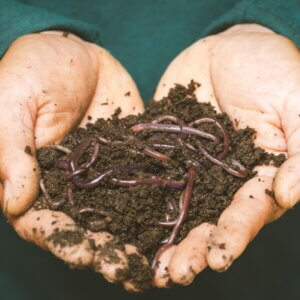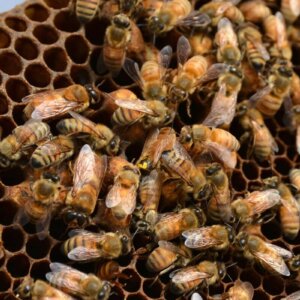I tend to be a “glass half full” sort of person, particularly about the prospects of successfully feeding the 9-10 billion people we expect by 2050. My optimism is based on daily contact with the innovative public and private entities who develop technology for agriculture. It is also based on the track record of small and large farmers who integrate these new options into their production systems.
Farming has the largest physical “footprint” of any human enterprise, so it will never be without consequences. I believe that feeding 10 billion people well while preserving the environment in within the realm of possibility. Even so, I have some concerns about how we are going to pull this off. My list of existential threats includes:
- Rising energy costs
- Peak Phosphorus
- An aging workforce
- Our lack of a viable and humane guest worker program
- The low level of land ownership by farmers
- Climate change
- Competition for water
- Pest resistance to chemicals and genetic traits
- A failure to invest public funds in agricultural research
- The growing influence of anti-science forces
- Rising uncertainty about private investment in agricultural research
Rising Energy Costs
After labor , land, and often water, the next largest cost of most farming operations is energy. It takes fuel to drive tractors and combines. It takes energy to manufacture and transport fertilizers. It takes energy to heat, light or cool greenhouses, and it takes energy to chill, store and transport food. As we move into an era of “peak oil,” it becomes difficult to simply pass along these rising costs to consumers – particularly to the poor. The solutions are the use of waste heat and the use of LED lighting at only the wavelengths needed for plant growth.
Peak Phosphorus
Phosphorus is the second most important element for plant growth. It has been mined from deposits of “phosphorus rock” and released with acid to make commercial fertilizer. Those mines are running out and soon the only major source will be in North Africa. That is not a good scenario. Phosphorus is soluble in water, so some of it moves into ground water and into streams and rivers. It is as much a driver of the Gulf “dead zone” as is nitrogen. We can reclaim phosphorus in rivers and particularly in from municipal waste, but the process is expensive. We need to drive down that cost and start re-using all this fertilizer we are currently wasting.
An Aging Workforce
Farmers are far older, on average, than the general population. Not that many young people desire to become farmers and those that do tend to believe that working on a small, Organic farm is actually a meaningful contribution to the food supply. Our best hope in this respect is increasing mechanization and robotic farming. The success of the game, Farmville, suggests a latent interest which could lead to a generation of farmers who may move from the virtual farm world to the physical with no change of user-interface.
Our Lack Of A Viable And Humane Guest Worker Program
The drive to force all employers to use E-verify for their employees has the looming consequence of creating severe agricultural labor shortages. Any crop that requires hand labor to plant, tend or harvest is at risk. Hopefully the early adopting states like Arizona and Georgia will demonstrate the folly of our dysfunctional system. There is a huge opportunity to rationalize this labor pool, removing the inefficiency of connecting workers and employers, providing mobile housing and safety training. There is no reason to defy gravity and pretend that there is not a market for guest workers on farms. We may never be able to be reasonable about immigration in a comprehensive fashion, but we could address farm labor separately.
The Low Level Of Land Ownership By Farmers
Truly sustainable farming is a wise, long-term investment, but since most farmers rent the majority of their land on an annual, cost-basis, they cannot actually afford to farm in the best possible way (no-till, cover crops, controlled wheel traffic, variable-rate fertilization…). It is not feasible for most farmers to buy more land, but the structure of leases could be modified so that both the farmer and the absentee land owner share in the increased stability and quantity of yield on soils which are improved in terms of rain capture and retention
Climate Change
Climate change is real to farmers. Temperatures are generally higher. Rainfall is more variable with both more dry and wet spells that lower productivity. The range of pests is expanding as temperature or the timing of rains enables them. The improvement of soil properties is the main possible response to this threat. The second is the expansion of “protected culture” like high tunnels, rain- shields, screen houses or even full-blown greenhouses.
Competition For Water
When city dwellers and farmers compete for the same water supply, the farmers are clearly going to lose. Even where there is not competition farmers face rapidly depleting aquifers, rivers that never reach the sea, salinity problems and the maze of water law and environmental regulation. The main solution is highly efficient irrigation systems which are capital intensive and require steady maintenance.
Pest Resistance To Chemicals
New families of insecticides and fungicides are being discovered on a regular basis, but new families of herbicides are rarely found. Several modes of resistance to glyphosate (Roundup) have emerged in recent years – actually much more slowly than for many other classes of herbicides. This threatens not only Monsanto’s trait dominance, but also the feasibility of no-till and strip-till systems which are at the core of sustainable practices. Re-doubled discovery efforts are needed as are new herbicide tolerance traits for different herbicide classes. The global wheat crop is now threatened by a new strain of stem rust, UG99 that first appeared in Uganda. A coordinated, global breeding effort is underway and it is a race against time to get new sources of resistance back-crossed into locally adapted and quality checked lines. Our dysfunctional congress just voted to reduce funding for this effort.
A Failure To Invest Public Funds In Agricultural Research
Concerns about some of the negative features of the “Green Revolution” and complacency developed over years of relative abundance, have induced many governments to cut back on investment in agricultural research even though statistics indicate this to be one of the highest return rate public investments that can be made. There is a widespread delusion that “agro-ecology” and traditional wisdom will feed the world which it has clearly failed to do. If it were not for the generosity of foundations like Gates and Buffet, the situation would be even more dire.
The Growing Influence Of Anti-Science Forces
A host of voices are terrifying the public with disinformation about GMOs, pesticides, and other key elements of agricultural productivity. This fear infects both the Right and the Left and is well funded by shadowy benefactors. Environmentalism that sees humanity as the source of solutions is a good thing, but the environmentalism that sees humans as the main problem is a real threat to the future. The Environmental Working Group is promoting cancer in humans by reducing their intake of cancer-fighting fruits and vegetables and by frightening them away from using sunscreens.
Rising Uncertainty About Private Investment In Agricultural Research
It costs a lot of money to maintain a pesticide screening effort. Because of the fear industry, the uncritical press and the under-qualified political leadership, the companies that invest billions in R&D cannot count on a reliable reward for their efforts. Uncertainties on the regulatory and market front have a chilling effect on investment at the same time that generics are cutting into their profitability. This will not only effect farmers. This discovery engine is also what finds all the actives for public health-oriented pest control (mosquitoes, roaches, bedbugs…).
Each of these issues can be addressed with sufficient time, funding and creativity, but global agriculture is facing them all, simultaneously. It is an enormous challenge.
You can email me at savage.sd@gmail.com. My website is Applied Mythology










































Plus loss of topsoil & genetic diversity
Gil,
Good call
Just take a look at the website of the Environmental Working Group to gain some insight into their true motives. They stress it’s very important to them to continue to provide you with their cutting-edge research and easy to use consumer guide. All they need is your help to do it. Give them just $10 today and you will be sent EWG’s exclusive shopping note pad featuring its Clean 15 and Dirty Dozen lists as a big special thank-you. Furthermore, click on the link seeking donations: give $10, $25, $50, $100 or however much you can afford to prevent the produce and pesticide industries – and federal agencies – from colluding to poison you and your children.
It appears that EWG sees black helicopters under every bed sheet and wants consumers to join in its paranoid delusions. Just send them money and they vow to fight to keep the demons at bay. Its list isn’t labeled “dirty” for nothing. In their opinion, there’s both a dirty conspiracy between industry and the regulators, right along with the contaminated peaches and plums.
It’s disingenuous and damaging for environmental activist groups to shout fire in a crowded theater when there’s no sign of a flame. It’s a fact that pesticides can be harmful if wrongly used; it’s extremely naïve to believe otherwise. There are associated risks involved and the crop protection industry, growers and government regulators fully realize this and take the appropriate precautions; remember, we all drink from the same well.
Richard,
very good points. I do wonder what you would find if you “follow the money” here. Do they invest in casket manufacturers?
Richard,
following your reasoning (‘we all drink from the same well’), the following things have never happened :
– asbestos companies sponsored ‘scientific’ studies in the 50’s to hide the truth
– Reynolds Tobacco has remained free of litigation till 1996 by making ‘the other son of a bitch spend all of his [money]’
– Bayer’s Cutter Biological division hasn’t tried to hide the fact that HIV could be passed on by non heat-treated plasma they happened to sell
It is a never ending story : the industry claims it can regulate itself (or almost) and governements claim they have the situation under control. Tacitus wrote 2000 years ago : corruptissima re publica, plurimae leges (the more the republic is corrupt, the more we have laws).
Regarding the well, keep in mind that some people can afford buying bottled water and don’t care about the well.
Marc, your list is selective.
Where is the evidence that residues of pesticides metabolites pose anything like the risks associated with asbestos, tobacco, or HIV?
Your choice of comparisons suggest bias on your part, like when bigots compare homosexuality to child molestation and bestiality.
Notice how I just did the same thing? It was for rhetorical reasons.
Mike,
Re. your first question, many products have been withdrawn from the market due to their toxicity. Unfortunately, it happens most of the time well after they have been used. It is only after more than 30 years of use of glyphosate that there are scientific studies stressing its carcinogenicity.
The product used in the comparison does not matter. I simply try to make it clear that the industry should not be trusted ‘by nature’ and that people in governmental organizations can fail.
As far as the bias is concerned, I have never hidden the fact that I am an organic farmer.
Wow, Richard. Plagerism? Much. Unless, of course, you are now writing for a newspaper in Montreal, Canada. Try to have an original thought. As for the blog – the numbers, the true numbers, are being hidden from most, if not all, folks. China has more than 2-billion people, overwhelmingly male, but still – we are well past 7-billion. And one more, tiny thing. For the record, here is some information to chew on – it’s a year behind (1910, not 1911), but it will help:
Here are some statistics for the Year 1910:
• The average life expectancy for men was 47 years.
• Fuel for a new car was sold in drug stores only.
• Only 14 percent of the homes had a bathtub.
• Only 8 percent of the homes had a telephone.
• There were only 8,000 cars and only 144 miles of paved roads in the U.S. – even less in Canada.
• The maximum speed limit in most cities was 10 mph.
• The tallest structure in the world was the Eiffel Tower.
• The average U.S. wage in 1910 was 22 cents per hour.
• The average U.S. worker made between $200 and $400 per year.
• A competent accountant could expect to earn $2000 per year, a dentist $2,500 per year, a veterinarian between $1,500 and $4,000 per year, and a mechanical engineer about $5,000 per year.
• More than 95 percent of all births took place at HOME.
• Ninety percent of all doctors had NO COLLEGE EDUCATION. Instead, they attended so-called medical schools, many of which were condemned in the press AND the government as ‘substandard’.
• Sugar cost four cents a pound; eggs were fourteen cents a dozen; coffee was fifteen cents a pound.
• Most women only washed their hair once a month, and used Borax or egg yolks for shampoo.
• Canada passed a law that prohibited poor people from entering into their country for any reason.
• The Five leading causes of death were:
1. Pneumonia and influenza
2. Tuberculosis
3. Diarrhea
4. Heart disease
5. Stroke
• The American flag had 45 stars.
• The population of Las Vegas, Nevada was only 30.
• Crossword puzzles, canned beer, and iced tea hadn’t been invented yet.
• There was no Mother’s Day or Father’s Day.
• Two out of every 10 adults couldn’t read or write and only 6 percent of all Americans had graduated from high school.
• Marijuana, heroin, and morphine were all available over the counter at the local corner drugstores. Back then pharmacists said, ‘Heroin clears the complexion, gives buoyancy to the mind, regulates the stomach and bowels, and is, in fact, a perfect guardian of health’
• Eighteen percent of households had at least one full-time servant or domestic help
• There were about 230 reported murders in the ENTIRE U.S.A!
• And the U.S. constitution is still on HEMP paper – an agricultural plant completely banned.
Have a nice day.
More information on the funding of the Environmental Working Group. See how they are ripping taxpayers off: http://bit.ly/iwaAY1